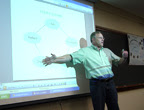A recent cartoon from Baby Blues (Kirkman & Scott) provides some interesting perspectives on inquiry in action. The first panel has young Zoe helping her younger brother, Hammie, into the house and saying that Hammie had stepped on a thistle barefoot in a vacant lot; Hammie of course is very vocally expressing the pain caused by the experience. The second panel shows mom saying that the vacant lot is full of thistles and asking him where were his shoes. Hammie replies that he had taken them off. The third panel shows mom asking him why he had taken them off, to which Hammie’s reply is “To see if it hurts to step on a thistle.” The fourth panel has mom releasing a deep sigh with her head hung down, while Hammie observes that she is acting like it was all his fault.
Hammie employed the inquiry process to perfection, first asking a question about whether a thistle hurts when stepped on barefoot. Whether or not someone had previously told him it would hurt was not relevant to his drive for self-discovery. His investigation into the question, that is, stepping on the thistle, created for him a very personalized answer to the question. He showed the initiative to undertake that inquiry on his own. His discussion with mom brought her into an intersection with his inquiry process, resulting in two divergent paths of reflection. For mom, it probably was wondering what sort of kid would be so dumb as to purposefully subject themselves to pain. Hammie, on the other hand was perfectly happy with the result of his inquiry. The pain is temporary, the knowledge lasts forever. He no longer would have to take someone else’s word about the thistle hurting. He had personalized the learning from his inquiry. His subsequent reflection, expressed in the last panel, related more to his response to his mom’s interpretation of the success or failure of his inquiry, and worrying about why he might be to blame for her misinterpretation of his learning.
How often in higher education do we allow our students to take the level of risk where they might meet with negative consequences? Not often. We are, appropriately, concerned for their physical and mental safety. As teachers we need to try to be more aware of how the student interprets their successes and failures, and help them reflect on their outcomes rather than encouraging them to worry about whether their learning from inquiry matches with our perceived expectations as teachers. Did Hammie’s mom miss a teachable moment? It is not easy for us to fully appreciate someone else’s inquiry when we only intersect with their inquiry cycle at one brief point, in this case after a moment of discussion. We need to listen carefully and the inquirer needs to communicate their experience effectively. This is another reason why shaping the student’s habits of mind and building the student’s cognitive skills allows them to better communicate about their inquiry. But it also points to the value of shared inquiry, working in teams, collaborative learning, etc, where the collective experiencing of a focused inquiry provides additional richness of the learning outcomes.
For another example of this intersection of someone with one of Hammie’s inquiry processes, see Thursday, July 10 2008 at www.babyblues.com (see Archive).
Thursday, August 14, 2008
Subscribe to:
Posts (Atom)




